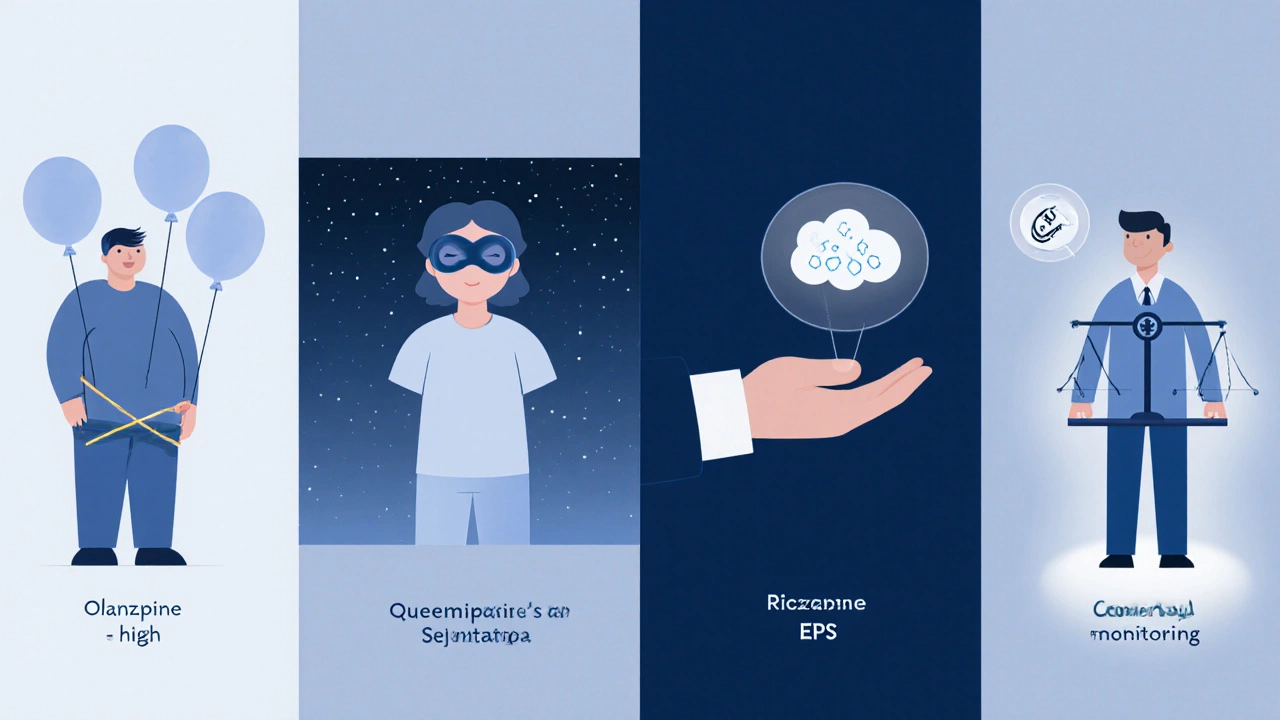Olanzapine vs Other Antipsychotics Comparison Tool
Olanzapine Profile
Core Characteristics
- Indications: Schizophrenia, Bipolar I
- Dosing: Once daily
- Efficacy: Rapid symptom control
Key Concerns
- High risk of weight gain (+6-8 kg in 6 months)
- Metabolic syndrome risk
- Moderate sedation
Selected Medication Profile
Core Characteristics
- Loading...
Key Concerns
- Loading...
Comparison Summary
Metabolic Impact
-
Movement Side Effects
-
Sedation Level
-
Quick Takeaways
- Olanzapine is effective for schizophrenia and bipolar I but carries a high risk of weight gain and metabolic issues.
- Risperidone offers strong dopamine blockade with moderate sedation and lower metabolic impact.
- Quetiapine is useful for insomnia and mood stabilization but can cause considerable drowsiness.
- Aripiprazole’s partial dopamine agonism reduces extrapyramidal symptoms and weight gain, making it a good option for patients worried about side effects.
- Clozapine remains the gold standard for treatment‑resistant schizophrenia, yet it requires strict blood monitoring due to rare but serious blood disorders.
Choosing the right antipsychotic feels a lot like picking a pair of shoes-what fits one person perfectly might pinch another. Olanzapine comparison is at the heart of that dilemma for many dealing with schizophrenia or bipolar disorder. Below you’ll find a plain‑English guide that breaks down how Zyprexa (Olanzapine) stacks up against the most common alternatives, what side‑effect profiles to watch, and how to decide which medication aligns with your health goals.
What Is Olanzapine (Zyprexa)?
Olanzapine (brand name Zyprexa) is an atypical antipsychotic approved for the treatment of schizophrenia and bipolar I disorder. It works by blocking dopamine D2 and serotonin 5‑HT2A receptors, helping to calm psychotic thoughts and mood swings.
Olanzapine’s strengths include rapid symptom control and a once‑daily dosing schedule, which many patients find convenient. However, the drug is notorious for causing weight gain, high cholesterol, and increased blood sugar-issues that can turn into long‑term metabolic syndrome if not managed.
Key Alternatives to Consider
Below are the five antipsychotics most frequently compared with Olanzapine. Each has its own balance of benefits and drawbacks.
Risperidone is a second‑generation antipsychotic commonly prescribed for schizophrenia, bipolar disorder, and irritability associated with autism.
Quetiapine (brand name Seroquel) is an atypical antipsychotic that also functions as a mood stabilizer and sleep aid.
Aripiprazole (brand name Abilify) is a dopamine‑partial agonist antipsychotic known for a lower risk of weight gain and movement disorders.
Clozapine is the most effective agent for treatment‑resistant schizophrenia, but it requires regular blood monitoring for rare agranulocytosis.
Schizophrenia is a chronic brain disorder characterized by delusions, hallucinations, disorganized thinking, and impaired functioning.
Bipolar disorder is a mood disorder marked by alternating periods of depression and mania or hypomania.
Antipsychotic is a class of medication that modulates dopamine and serotonin pathways to reduce psychotic symptoms.
Decision Criteria: How to Compare
When you line up Olanzapine against its rivals, think about these five factors. They’re the questions you should ask yourself (or your doctor) before settling on a prescription.
- Efficacy for core symptoms - Does the drug reliably control hallucinations, delusions, and mood swings?
- Metabolic impact - How likely is weight gain, high blood sugar, or cholesterol changes?
- Movement side effects - Does the medication cause tremors, stiffness, or restlessness (extrapyramidal symptoms)?
- Sedation and daily functioning - Will you feel drowsy, or can you stay alert for work and school?
- Practical considerations - Cost, dosing frequency, and need for lab monitoring.

Side‑Effect Profiles in Plain Language
Side effects are the part of medication that most people worry about. Below is a quick snapshot of how each drug typically behaves.
| Medication | Weight Gain / Metabolism | Movement Disorders | Sleepiness (Sedation) | Monitoring Required |
|---|---|---|---|---|
| Olanzapine | High (average +6‑8kg in 6months) | Low to moderate | Moderate | Basic labs (glucose, lipids) every 6months |
| Risperidone | Low to moderate | Higher risk of EPS, especially at >4mg/day | Low | Prolactin check if dose >4mg |
| Quetiapine | Moderate (often +3‑5kg) | Low | High (often used as nighttime sedative) | None unless high dose (>600mg) |
| Aripiprazole | Low (usually stable weight) | Low | Low | No special labs needed |
| Clozapine | Moderate to high | Low | Low to moderate | Weekly WBC count for first 6months, then bi‑weekly |
Cost and Accessibility in 2025
Price matters, especially if you’re paying out‑of‑pocket or rely on Medicare/Pharma benefits. In Australia, the Pharmaceutical Benefits Scheme (PBS) subsidises most antipsychotics, but the out‑of‑pocket cost can still differ.
- Olanzapine: PBS‑listed; typical co‑payment aroundAU$30‑$45 per month.
- Risperidone: Often cheaper than Olanzapine, co‑payment roughlyAU$20‑$35.
- Quetiapine: Mid‑range pricing; co‑payment aboutAU$30‑$40.
- Aripiprazole: Generic versions lower cost; co‑payment aroundAU$25‑$40.
- Clozapine: Higher due to monitoring; co‑payment roughlyAU$50‑$70, plus lab fees.
Check your local pharmacy and the PBS schedule for the latest figures - they can shift with new generic releases.
When Olanzapine Is the Right Choice
If rapid control of severe psychosis is the priority, Olanzapine often wins on speed. It’s also a solid pick for patients who struggle with adherence because it’s taken once daily and works well at moderate doses (5‑10mg). For individuals with minimal metabolic risk (e.g., younger adults with active lifestyles), the weight‑gain side effect may be manageable.
When Another Antipsychotic Might Suit You Better
Consider these scenarios:
- High concern about weight or diabetes: Aripiprazole or Risperidone are gentler on metabolism.
- Need for a calming effect at night: Quetiapine’s strong sedation can help you sleep while still treating mood symptoms.
- History of movement disorders (tremor, rigidity): Aripiprazole and Clozapine have the lowest EPS rates.
- Treatment‑resistant schizophrenia: Clozapine is the only drug with proven superiority, despite the monitoring hassle.

Monitoring and Follow‑Up
Regardless of which antipsychotic you’re on, regular check‑ups are crucial. Here’s a simple schedule you can discuss with your psychiatrist:
- Baseline labs before starting - fasting glucose, lipids, liver enzymes, weight, BMI.
- First follow‑up at 2‑4weeks - assess symptom change and side effects.
- Monthly labs for the first three months, then every 3‑6months for metabolic markers.
- If you’re on Clozapine, add weekly white‑blood‑cell counts for the first six months.
Tracking these numbers yourself (a phone app or a paper log) can make appointments smoother and catch problems early.
Practical Tips for Managing Side Effects
- Weight gain: Pair the medication with a balanced diet and at least 150minutes of moderate exercise per week. Some clinicians add metformin to blunt glucose spikes.
- Sleepiness: Take the dose in the evening if possible, and avoid alcohol or other sedatives.
- Movement issues: If tremors appear, a dose reduction or switch to a lower‑EPS drug (like Aripiprazole) may help.
- Blood sugar spikes: Monitor fasting glucose at home if you have a family history of diabetes.
Bottom Line: Tailor the Choice to Your Priorities
The “best” antipsychotic isn’t a one‑size‑fits‑all label. Think of Olanzapine as the high‑performance sports car: fast, powerful, but thirsty for fuel (calories) and needs regular maintenance. Alternatives like Aripiprazole are more like hybrid sedans - slower on the speed chart but smoother on the road and cheaper to run.
Talk openly with your mental‑health provider, weigh the pros and cons listed above, and remember that you can always try a medication for a few weeks before deciding if it’s the right fit.
Frequently Asked Questions
How long does it take for Olanzapine to start working?
Most patients notice a reduction in hallucinations or mood swings within 1‑2 weeks, but full stabilization can take up to 4‑6 weeks at therapeutic doses.
Is Olanzapine safe during pregnancy?
Animal studies show some risk, and human data are limited. Doctors usually reserve Olanzapine for pregnant women who have severe psychosis and cannot use safer alternatives.
Can I switch from Olanzapine to Aripiprazole?
Yes, but the switch should be tapered over 1‑2 weeks under medical supervision to avoid withdrawal or symptom rebound.
What monitoring is needed for Clozapine?
Weekly white‑blood‑cell counts for the first six months, then every two weeks. Also check metabolic labs quarterly.
Do antipsychotics affect libido?
Some, like Risperidone, can raise prolactin and lower sexual desire. Aripiprazole tends to have the least impact on libido.


Taryn Esses
Olanzapine definitely works fast, but the weight gain can be a real pain.